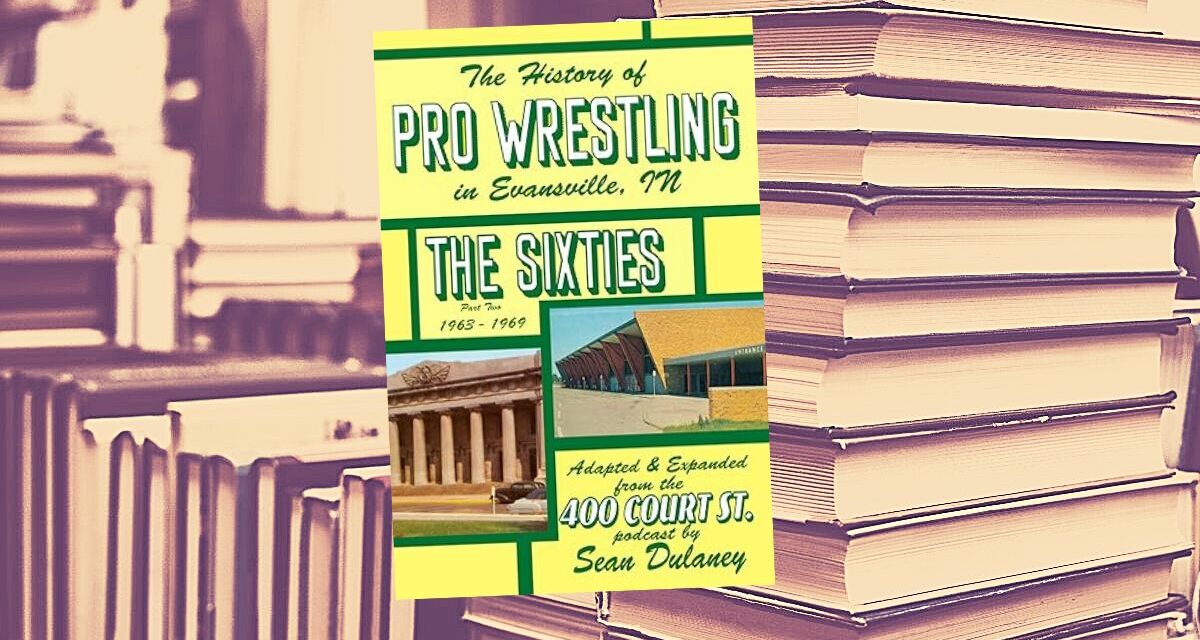Sean Dulaney’s The History of Professional Wrestling in Evansville, IN: The Sixties Part Two: 1963 – 1969 was released in November 2023. He shares his experiences working on the book here.
There’s a meme out there that I liked so much I actually made it the cover image for my Facebook page a while back. It’s a banner hanging in a gymnasium that reads, “We don’t do it because it’s easy. We do it because we THOUGHT it would be easy.” It not only summed up the experience of developing the “400 Court Street” radio show covering the history of professional wrestling in Evansville, Indiana, but it also applied – in spades – to the most recent book that has spun out of the show.
I thought the show was going to be easy. I was managing a group of radio stations that included a Fox Sports Radio affiliate and we had a local slot available on Sunday mornings. With the number of Memphis videos on YouTube – many from the Evansville broadcasts – I figured it would be a pretty easy show to throw together every week. But then I decided to try and go back to the start of the Jarrett promotional era. That took me back to the pre-Jarrett period. Before the show completed its run it covered the first meeting of Joe Stecher and Strangler Lewis, multiple promotional wars, and, maybe most importantly, the last big run of promoter Leon Balkin behind a newly-arrived Rip Hawk.
The month-by-month look at Balkin’s 1959 that turned his struggling local office around would, with a few revisions, result in the first book in the History of Professional Wrestling in Evansville series. The 1959 book was followed by 1960, covering Balkin’s success suffering cracks as previously silent partners began asserting their influence. After that I had to continue Balkin’s story, but unlike 1959 and 1960, I didn’t do a lot of shows about 1961 or 1962. The rest of the decade was going to be researched from scratch. That led me down some rabbit holes, including the Indianapolis office expanding their Evansville operation into neighboring Owensboro, Kentucky. The erratic scheduling after Balkin was removed as promoter allowed me to combine two years into one book. That’s where it stopped being easy.
Those first three books had easily defined themes. For 1959, it was the revival of the promotion and rise of Rip Hawk. With 1960, it was the question of how you maintain success when others are messing with the formula. For 1961-62, unfortunately, was the fall of Leon Balkin and the struggles of the business that followed. Researching the years that followed, I saw the schedules would become even more erratic which would allow me to combine 1963 through 1969 in one volume and let me start in on the Jarrett years ahead of schedule, but the easily defined theme of the previous books… Nowhere in sight.
But then I realized, that was the 1960s in a nutshell. Is there a decade that had a more radical shift in tone from beginning to end? That was the case with wrestling in both Evansville and Owensboro. The up and down status of Evansville events. The struggles of the Gulas/Welch office to maintain their foothold in Owensboro when their closest TV was in Bowling Green. The generational shift as longtime familiar faces retired, passed away or took off to work in a new area. As I worked my way through The Sixties Part 2 I finally had to accept the chaos. From one promoter going to jail to another leaving the country. From the local papers ignoring local results while picking up wire reports about stars from the glory days to how local politics affected the local cards. Like the decade, the side stories are the narrative. And, man, were there some side stories. But that brings us to another case of “Because we thought it would be easy.” When Greg Oliver and I discussed maybe doing an excerpt from the new book, it became a question of what side story to spotlight. Fate provided an answer.

The History of Professional Wrestling in Evansville, IN: The Sixties Part Two: 1963 – 1969
The “final” wrestling card to be held at the Evansville Veterans Memorial Coliseum was the December 15th show presented by Central City, KY-based WWA-Hysteria. It was the last card presented by the group that has been the resident promotion for the past ten years due to the building being shut down for long overdue renovations. As for it being the absolute last-ever-final-ain’t-welcome-here-no-mo’ wrestling card in the building, I have my doubts. In part because the last time wrestling was booted from the building, it led to one of the finest acts of Karma I’ve ever seen.
In the mid-1960s one of the big buzzwords was “Urban Renewal.” Especially in cities undergoing an economic downturn, which Evansville was as the post-war manufacturing boom dried up. Many buildings that would be considered historic from an architecture standpoint but little other historical significance were taken out by the wrecking ball to be replaced with modern designs that would provide construction jobs and hopefully create interest from businesses to move into the city rather than around the outskirts. In Evansville, the great urban renewal project by city and county leaders was construction of the Civic Center. A complex that would house city, county and federal governmental offices, an auditorium for the local orchestra and other concerts, a convention hall and a community center on the site of the now defunct Cook Brewing Company plant and the Chicago & Eastern Illinois Railroad Depot building that had served as the local USO during the war and later became the downtown community center. In 1965, since the demolition was getting underway and moving ahead of schedule, Mayor Frank McDonald (Sr.) decided to move the community center’s youth activities into the Coliseum, essentially displacing events planned for the facility. It’s unclear if Don “Farmer” Marlin and Gene Martin had planned to run any cards, as their last show coincided with losing their TV slot late in 1964. If they had, like the concerts, they would’ve been moved to another building in the county but there would be no wrestling cards announced in the city until 1968.
That was the year that Dick the Bruiser and Wilbur Snyder, who had taken over Indianapolis when Jim Barnett went to Australia, decided to lay claim to Evansville. Bruiser had a checkered history in the city. He was a major draw, as he was in most markets, but he also was arguably responsible for the demise of the Leon Balkin promotion thanks to no-showing a U.S. Title defense against Rip Hawk which drew the attention of the state athletic commission. Once Balkin was out and Barnett took over, Bruiser headlined outdoor cards at Bosse Field that drew crowds dwarfing the average Coliseum attendance, so he was no doubt confident they could take their WWA promotion south and rake in the cash but, the most familiar venue – the Coliseum – was still being used as a community center. The only other option that would work for pro wrestling was Roberts Stadium, the 13,500-seat arena that Balkin only ran on rare occasions due to its size. Having run large building and ballparks in Indianapolis, Bruiser and Snyder didn’t blink, paying the $400 deposit for their first Evansville date to be headlined by Snyder and Yukon Moose Cholak against the WWA tag champions Mitsu Arakawa and Dr. Moto, who had previously appeared in Evansville in the late 50s as “Tor Kamata,” with an undercard of Angelo Poffo vs. Bob Boyer, Assassin #1 vs. Prince Pullins and an opening bout of Dale Mann vs. Igor Volkoff. That event on September 11th brought in a crowd of… 500 people. Even in the Coliseum that wouldn’t be a great turnout, but would’ve at least been better visually in the 4,000 seat building vs. the 13,000+ seat barn.
Having already reserved Roberts Stadium for another date two weeks later, the WWA brain trust stepped up their promotion of the next card and even made Dick the Bruiser available to the local sports reporters for an interview. Bruiser would be teaming with Cholak against Arakawa and Moto as part of a double main event, the other half seeing Wilber Snyder challenging WWA “World” Champion Blackjack Lanza. Angelo Poffo vs. Prince Pullins and Bob Boyer vs. Johnny Kase made up the remainder of the lineup the Evansville fans would see for $3.50 ringside and $2.50 for lower bowl chairbacks. (For those curious about such things, in 2023 the ringside seats would be $30.96 and the chairback seats would run around $22.11.) The promotional push and addition of both Bruiser and Lanza improved the house, but not by much as a grand total of 1,008 fans turned out on September 25th.
Bruiser and Snyder would continue to run bi-weekly events at the stadium through November 1968 before pulling the plug following a “1st Annual Christmas Show” on December 18th. By the end of the year the WWA TV show would be pulled from its Evansville affiliate and aside from one high school’s senior class declaring “Yukon Moose Cholak Day” during their homecoming week, wrestling was done in Evansville until Jerry Jarrett signed a deal with WTVW-7 in 1970.
But that’s a story for the next book.
RELATED LINKS
- Buy The History of Professional Wrestling in Evansville, IN: The Sixties Part Two: 1963 – 1969 at Amazon.com or Amazon.ca
- Nov. 30, 2020: Dulaney takes readers on a time traveling trip back to 1959 Evansville
- Buy The History of Professional Wrestling in Evansville, IN: 1959 on Amazon.ca or Amazon.com
- Sean Dulaney: Twitter
- Listen to the 400 Court Street podcast
- The 400 Court Street podcast: Facebook
- BiMor Press: Facebook
- SlamWrestling Master Book List

